Last Updated on September 22, 2022
Almost every vehicle with an internal combustion engine uses either a timing chain or timing belt. These are critical components which over the life of a vehicle CAN fail.
This article will cover timing chains in particular. See “Symptoms of a Bad Timing Belt” in case your vehicle uses that instead.
What is a Timing Chain?
The timing chain is at the heart of your car, truck or SUV engine’s mechanical functionality. Proper and efficient engine operation is highly dependent on this critical part. Failure of the chain can leave you stranded alongside the road.
Worse, this can also result in severe damage to the internal components of the engine. In this regard, see the discussion regarding interference vs. non-interference engines on this site.
See Also: DOHC vs SOHC Engine
Types of Timing Chains
Two types of timing chains are in service today, the link chain and the roller chain. These designs have their origins back into the late 19th century.
Link chains consist of many precision links fabricated of flat hardened alloy steel held together by pressed pins. Each link’s shape conforms to the driving surfaces of both the crankshaft driving sprocket and camshaft driven sprocket.
The link shape is intended to smoothly engage each sprocket. For this reason, this design is sometimes referred to as a ‘silent chain’.
Roller chains are much like bicycle chains in appearance but are larger, far stronger and more durable. Their design enables them to pass around smaller diameter sprockets thus demanding less space than the link chain design.
For light duty automobile engines, the roller chain may be of a single row configuration (like the bicycle chain). Larger, more powerful engines demand a double row design. Roller chains operate in concert with high precision alloy steel sprockets.
Timing chains are enclosed in a housing located typically on the front of the engine. This housing is sealed and the chain(s) are lubricated and wear particles flushed away by the engine oil system.
Timing chains should not be confused with the timing belt which serves the same function but is uniquely different in design as well as failure modes.

How a Timing Chain Works
The timing chain operates the engine’s intake and exhaust valves. These valves must open and close in precise coordination with the motion of the pistons.
The pistons drive the crankshaft. A sprocket on that shaft drives the timing chain which in turn rotates the camshaft to operate the valves.
When the engine runs, the motion of each valve is precisely synchronized to the arrival and departure of each moving piston. This synchronized event is called ‘correct valve timing’. It is the timing chain that makes this valve and piston coordination possible.
See Also: Variable Valve Timing (VVT) Engine Advantages
Engine designers often use the timing chain to operate other engine components like the fuel pump, distributor, balance shaft(s), and/or the oil pump. Additional timing chain design features may include chain guides to constrain chain motion and reduce noise.
Idler sprockets may be present to change the chain path of travel. And one or more timing chain tensioners may be employed to keep the chain taut and to account for eventual chain stretch.
Depending on your engine configuration, it may have just one timing chain or several. While several timing chains complicate the system, the basic functionality remains unchanged.
Here’s a good video showing the basics of how a timing chain works:
Bad Timing Chain Symptoms
Over the past twelve decades since the automobile appeared on the scene, timing chain system designs have become extremely durable. For this reason, timing chain failures are rare. Of course, age can play a role.
Things get old and simply wear out. Vehicles with over 150,000 miles of accumulated wear can be more likely to experience timing chain problems.
Here are six symptoms of impending or actual timing chain failure:
#1 – Stretched Timing Chain
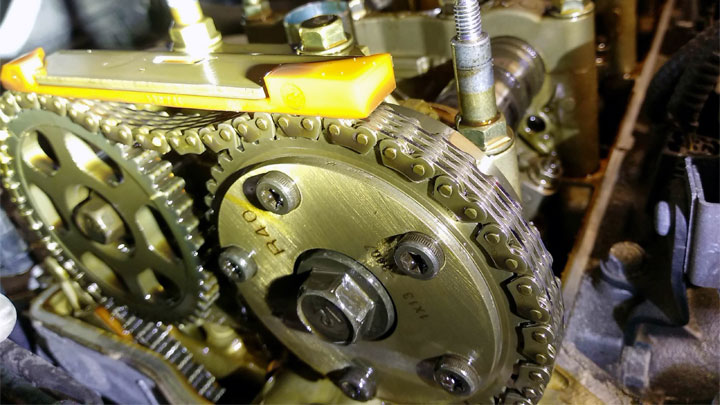
Over time, the timing chain will stretch due to wear. Correct valve timing will degrade. This will be noted by an increase in fuel consumption, reduced power at low engine speeds and an increase in roughness.
The stretched chain also may become noisy, producing a rattling or clattering sound. This sound will be evident with the hood open and it will vary with engine speed.
#2 – Worn Timing Chain Sprockets or Idlers/Tensioners
This problem will display the same symptoms as a stretched chain. Additionally, idler and tensioner bearings may become worn leading to whirring sounds apparent during engine operation. This sound will grow louder with increased engine speed.
#3 – Worn Chain Guides
This age-related condition will result in noisy chain operation. Chain rattle or clatter especially at low engine speeds may be noted.
#4 – Timing Chain That Jumped From Its Idler or Tensioner
When a timing chain jumps off one of its sprockets, the engine will suddenly stop running. Loud clattering or grinding may also be noticed just prior to the engine quitting.
#5 – Visually Broken Timing Chain
A broken chain will produce the same symptoms as the timing chain jumping off one of its sprockets. Considerable engine damage is very likely with both of these failure modes.
#6 – Check Engine Light
The Check Engine Light may come on if valve timing exceeds certain preset limits and/or exhaust emissions go out of spec. A CEL warning necessitates immediate evaluation by a qualified service technician.
Ignoring this warning can lead to severe damage to your engine and associated systems. For a timing chain failure, this warning will occur for some but not all makes of automobiles.
Related: Code P0017 Causes
What Causes Timing Chain Noise?

Timing chain noise may be evident prior to a complete chain failure. Problems (1) through (3) described in the section above are typical causes of chain noise. Additionally a mis-adjusted tensioner (too loose) may cause timing chain noise.
The moving chain begins to strike or rub against nearby engine parts. If not soon corrected, wear debris could be flushed into the oil pan, picked up at the oil inlet and then partially or completely clog the oil filter.
Keep in mind that these noises can also be a precursor to chain failure. Should these be heard, a problem diagnosis by a qualified service technician is strongly recommended.
What Causes a Timing Chain to Break?

The timing chain may break due to any of these causes:
- If the chain has an adjustable tensioner, this may have been set too tight during a periodic maintenance event. An overly tight adjustment here will overload the structure of the chain, guides and sprockets leading to accelerated wear. This wear could result in chain breakage.
- As any vehicle ages, normal life-related wear on the chain and its components plus the degradation of the guides and sprockets may initiate chain breakage.
- Overly frequent continuous operation of the engine at or near its redline, i.e., maximum speed (at track day events, for example) may overheat and excessively wear the timing chain, guides and sprockets. This could lead to chain breakage.
- Failure to follow periodic engine oil and filter changes may adversely affect timing chain life. Old sludge-contaminated engine oil can lead to accelerated wear of the timing chain, guides and sprockets. This could result in chain breakage.
Timing chain life and the life of the entire engine may be prolonged by faithfully performing regular maintenance as recommended by the manufacturer. Specifically, periodic oil and filter changes will prove to be especially beneficial.
Use of a full synthetic oil (instead of conventional) of the correct viscosity can additionally reduce engine wear lengthening its overall service life. See your owners’ manual for maintenance and lubricant recommendations.
What Happens When a Timing Chain Breaks While Driving?
Outcomes of a failed timing chain while driving are discussed HERE.
When Should a Timing Chain Be Replaced?
Timing chain systems are designed to endure for the life of the vehicle. Periodic replacement of the chain is not required.
However, if noise symptoms or engine operational characteristics (1), (2), (3) or (6) described in “Bad Timing Chain Symptoms” above are noted, evaluation by a qualified service technician is required.
Replacing the worn timing chain or chains will be a costly service. But far better this expense than a complete engine rebuild, replacement or possibly a new car that might be needed if the chain fails.
Timing Chain Replacement Cost
Best places to order parts? See: 19 Best Online Auto Parts Stores
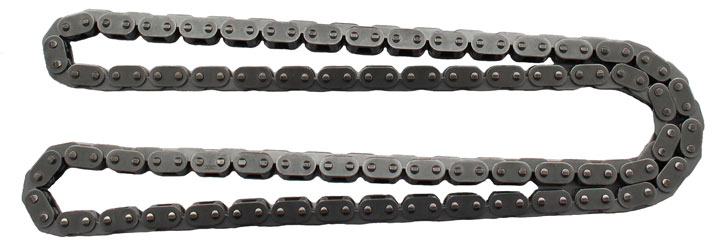
Timing chain replacement costs vary widely. This variation is based primarily on labor cost differences related to accessibility to the engine and the complexity of the timing chain system itself.
On average, you can expect labor costs of $400 to $1,000 and parts costs of $200 to $600. Total costs might range from $600 to $1,600. Pricing at your local dealer may be even higher than at a local repair shop.
These cost estimates would cover the timing chain replacement only and not account for the potentially severe damage inflicted on the engine by a failed timing chain.
Should You Replace a Timing Chain Yourself?
Unless you are an extremely skilled DIY mechanic with all of the essential tools and tons of experience, the answer would be NO. You’d be best served by assigning this complex job to a competent shop or dealer that does this kind of thing every day.

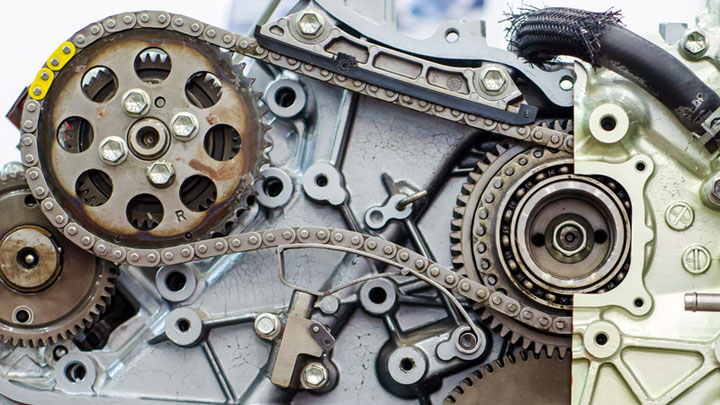
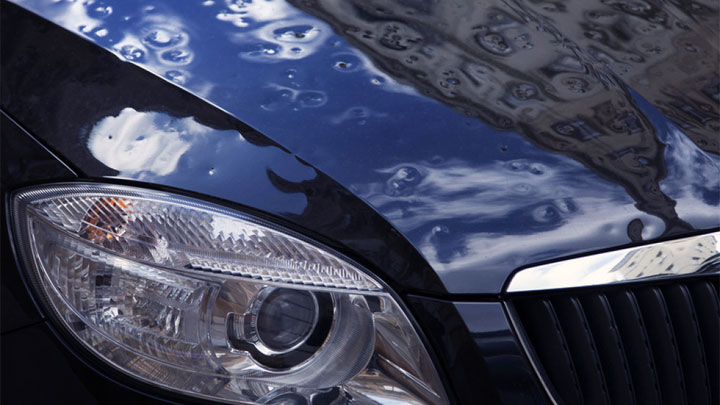
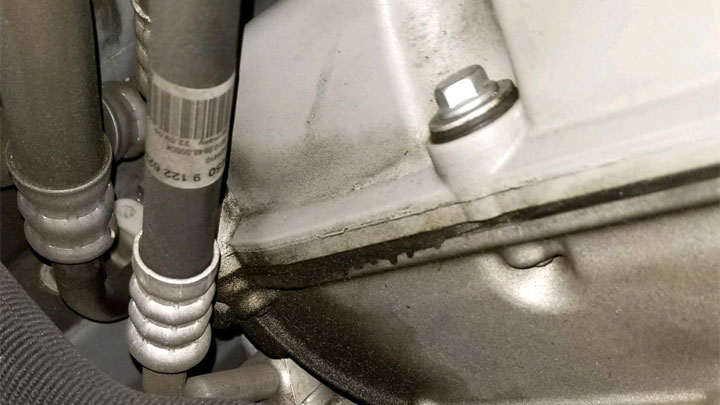
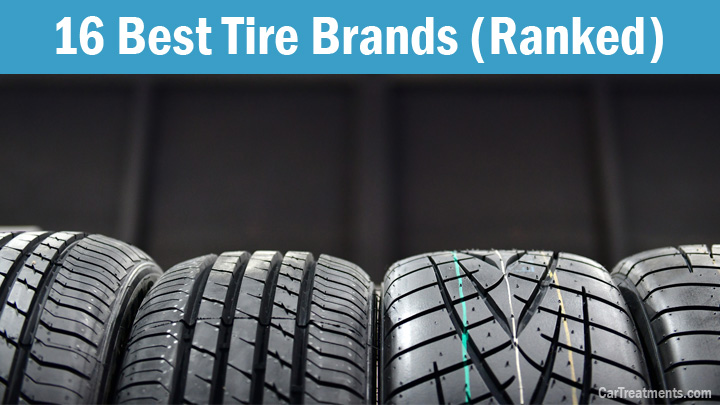
If ur timing breaks when ur idling ur car, will it still damage ur engine like if you broke as you was driving
Yes, if your vehicle has an interference engine.
2016 Renault Clio with only 31000km travelled.
Is it feasible vehicle requires new timing chain ?
Regards Christine
It’s highly unlikely. What problems are you experiencing with the vehicle?
I have a 320D from 04. Could a stretched timing chain cause excessive black smoke on acceleration?
Smoke has recently got quite bad, and there is a new sound like a gurgle that I can’t quite place.
I think it’s quite unlikely. The smoking problem is probably caused by another component that is dirty or needs replacing.